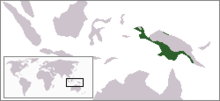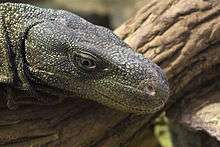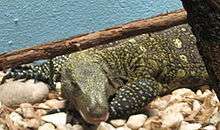Varanus salvadorii
| Varanus salvadorii | |
|---|---|
 | |
| Scientific classification | |
| Kingdom: | Animalia |
| Phylum: | Chordata |
| Class: | Reptilia |
| Order: | Squamata |
| Family: | Varanidae |
| Genus: | Varanus |
| Subgenus: | Papusaurus |
| Species: | V. salvadorii |
| Binomial name | |
| Varanus salvadorii | |
 | |
| Estimated range of V. salvadorii, indicated by green[2] | |
| Synonyms[3] | |
Varanus salvadorii is a species of monitor lizard endemic to New Guinea. Its common names include crocodile monitor, Papua(n) monitor, Salvadori's monitor and artellia.[4] It is the largest monitor lizard known from New Guinea, and is one of the longest lizards in the world, verified at up to 244 cm (8 ft). The tail of the species is exceptionally long, so that some specimens have been claimed to exceed the length of the world's largest lizard, the Komodo dragon; however, Varanus salvadorii is far less massive.
Varanus salvadorii is an arboreal lizard with a dark green body marked with bands of yellowish spots. It has a characteristic blunt snout and a very long tail. It lives in mangrove swamps and coastal rainforests in the southeastern part of the island, feeding on birds, small mammals, eggs, and carrion. Its teeth are better adapted than those of most monitors for seizing fast-moving prey. Like all monitors, Varanus salvadorii has anatomical features that enable it to breathe more easily when running than other lizards can, but it may have even have greater stamina than most other monitor species. Little is known of its reproduction and development, as the species is difficult to breed in captivity.
Varanus salvadorii is threatened by deforestation and poaching, and is protected by the CITES agreement. The lizard is hunted and skinned alive by tribesmen to make drums, who describe the monitor as an evil spirit that "climbs trees, walks upright, breathes fire, and kills men"; yet the tribesmen maintain that the monitor gives warnings if there are crocodiles nearby.
Taxonomy and etymology
Varanus salvadorii was first described as Monitor salvadorii by Wilhelm Peters and Giacomo Doria in 1878 from a female specimen with a snout-to-vent length of 48 cm (19 in), and a tail measuring 114 cm (45 in) in length.[4]
It is the sole member of the subgenus Papusaurus.
The generic name, Varanus, is derived from the Arabic waral (ورل), meaning "lizard". The term "monitor" is thought to have come about from confusion between waral and the German warnen, meaning "warning". The term "goanna" came about as a corruption of the name "iguana". The specific name, salvadorii, is derived from a Latinization of Tommaso Salvadori,[5] an Italian ornithologist who worked in New Guinea.[1] Later, in 1885, it was renamed Varanus salvadorii by George Albert Boulenger. The Papua monitor is occasionally confused for the Asian water monitor (V. salvator) because of their similar scientific names.[6]
Evolutionary origins
The evolutionary history of salvadorii started with the genus Varanus, which originated in Asia about 40 million years ago. Around 15 million years ago, a tectonic connection between Australia and Southeast Asia allowed the varanids to spread into what is now the Indonesian archipelago.[7]
Based upon mitochondrial DNA and microcomplement fixation analysis, cladistic studies identify Varanus salvadorii as a member of a species cluster that includes the lace monitor (V. varius) and the Komodo dragon (Varanus komodoensis). One theory suggests that the species diverged from a common ancestor, as the Torres Strait separating New Guinea from Australia is less than 90 km (56 mi) long, a distance that could have been covered fairly easily with island hopping. Alternatively however, the similarities between V. salvadorii and V. varius may be the product of convergent evolution.[2] Another clade postulated by Eric Pianka places V. salvadorii in a larger "Australian" clade of large monitors, along with other species as the Komodo dragon, the lace monitor, the perentie (V. giganteus), the Argus monitor (V. panoptes), and the sand goanna (V. gouldii ).[8]
Distribution
The largest of the seven species of monitors found on the island of New Guinea, V. salvadorii occurs in both the state Papua New Guinea and the Indonesian region of West Papua. It inhabits the high and low canopies of the lowland rainforests and coastal mangrove swamps, sometimes venturing out of these areas during floods in the rainy seasons. No detailed field investigation data are available for V. salvadorii, so the full extent of its range is unknown.[2][4] Its remote and generally inaccessible habitat is an obstacle to detailed study of this monitor in its natural habitat.[2][4]
Biology and morphology

The most characteristic feature of V. salvadorii is its blunt, bulbous snout, which makes this species look different from every other monitor on New Guinea, and suggested the common name tree crocodile.[4] The body of the lizard is dark green with rings of yellow spots.[9] The tail is banded yellow and black and is extremely long, more than twice as long as the snout-to-vent length.
Its teeth are long, straight and sharp. Its claws are prominent and strongly curved. There is no clear external sexual dimorphism.[10]
Various descriptions are mutually inconsistent; but there is agreement that Varanus salvadorii is unique among extant varanid species, in that the animal's tail is much longer than the snout-to-vent length in both juveniles and adults. One figure[4] gives the tail as two thirds longer, whereas another states that the tail is 210% of the animal's body length.[11]
At hatching, Varanus salvadorii is about 45 cm (18 in) long. Reports of the maximal length vary greatly and are the subject of much dispute. Varanus salvadorii possibly attains the greatest length among extant species of lizard. Although it is considerably less massive than the Komodo dragon.[12] Specimens are known to reach at least 244 cm (8.01 ft) in length.[13] but it has been claimed to grow much longer.[11][14] A specimen measuring 323 cm (10.60 ft) reportedly was caught in Konedobu by Dr. F. Barker.[12] Claims that some specimens considerably exceed such lengths are so far unsupported.[12]
Claims of Varanus salvadorii attaining large weights also are unverified; the species is much slenderer than Komodo dragons of comparable length.[12][15] The typical reported length of this species is less than 200 cm (6.6 ft) with a matching body mass of about 20 kg (44 lb).[16][17] However 10 adult specimens were found to weigh only 5 to 6.38 kg (11.0 to 14.1 lb) at a length of 1.16 to 2.25 m (3.8 to 7.4 ft) so even the aforementioned weight is fairly optimistic for this species.[18] The average size of V. salvadorii caught in one study were 99.2 cm (39.1 in) with a weight of 2.02 kg (4.5 lb) but these must have been young specimens.[19]
Varanus salvadorii has mammal-like aerobic abilities; a positive pressure gular pump in the animal’s throat assists lung ventilation.[2][20] Unlike most lizards that cannot breathe efficiently while running, because of Carrier's constraint, the gular pump of monitor lizards enables them to overcome the effect of one lung at a time being compressed by their running gait.[20][21] The evolutionary development of the gular pump is functionally analogous to that of the diaphragm in mammals, which ventilates the lung independently of locomotion. Varanus salvadorii may be the species that achieves the greatest running endurance as a result of its gular pump.[2][20] Investigation supports the idea that gular breathing is an evolutionary development that masks the effect of Carrier's constraint.[20]
Behavior

Varanus salvadorii is a highly arboreal lizard. It can hang onto branches with its rear legs occasionally using its tail as a prehensile grip. The primary function of the tail however, is as a counterbalance when leaping from branch to branch.[2] As in some other Varanus species, the tail also may be used for defense, as captive specimens may attempt to lash keepers with their tails.[22] This species occasionally is seen in the pet trade, but has a reputation for aggression and unpredictability.[4] Although they are known to rest and bask in trees, they sleep on the ground or submerged in water.[2]
These monitors will rise up on their hind legs to check their surroundings, behavior that also has been documented in Gould's monitors (V. gouldii).[6] They are known to exhibit a warning posture, in which they carry their tails rolled up behind them. According to native belief, they will give a warning call if they see crocodiles.[6] In general V. salvadorii avoids human contact, but its bite is capable of causing infection, like the Komodo dragon's.[6] One fatality was reported from a bite in 1983 when a Papuan woman was bitten and later died from an infection.[4]
Diet
The teeth of Varanus salvadorii do not resemble those of other monitor species, which typically are blunt, peglike, and face slightly rearward.[2] Their upper teeth are long, fang-like, set vertically in the jawbone, adapted to hooking into fast-moving prey such as birds, bats, and rodents. Their lower teeth are housed in a fleshy sheath. In the wild, V. salvadorii is the top predator in New Guinea, feeding on birds, eggs, small mammals, and carrion.[10] Natives have reported that it can take down pigs, deer, and hunting dogs, and hauls its prey into the canopy to consume it.[2] Captive specimens have been known to eat fish, frogs, rodents, chickens, and dog food.[4][23]
This species has been observed hunting prey in a unique fashion for monitor lizards.[2] Rather than following its prey to ambush it from behind, V. salvadorii will stalk its prey and anticipate where it will run, meeting it headlong.[2]
Reproduction
Reproduction of V. salvadorii has only been observed in captivity, so nothing is known about its reproduction in the wild. The egg clutches, comprising four to 12 eggs, are deposited around October to January, with the eggs showing a remarkable difference in dimensions, a phenomenon for which no explanation is known. Dimensions may vary from 7.5 cm × 3.4 cm to 10 cm × 4.5 cm (3.0 in × 1.3 in to 3.9 in × 1.8 in), while weight may vary from 43.3 to 60.8 g (1.53 to 2.14 oz). Most clutches laid in captivity have been infertile, and only four successful breedings have been documented thus far. Hatchlings are about 18 inches (46 cm) long and weigh around 56 g (2.0 oz). Like those of many other monitors, the hatchlings of V. salvadorii are more colorful than adults, and feed primarily on insects and small reptiles.[2][24]
Conservation status
Varanus salvadorii is currently protected under the CITES Appendix II,[25] which requires an exportation permit for international trade. It is not listed on the IUCN Red List or the Endangered Species Act.[26] It faces threats from deforestation and poaching, as it is hunted and skinned alive by native peoples to make drums, who consider the monitor an evil spirit that "climbs trees, walks upright, breathes fire, and kills men".[4][10] In 2008, a total of 52 individuals were maintained at 17 zoological parks in the United States, with an unknown number in private collections.[9]
References
- 1 2 Klipfel, Meghan; Peters, Wilhelm C. H.; Bauer, Aaron M.; Günther, Rainer (1995). The herpetological contributions of Wilhelm C. H. Peters (1815-1883). Ithaca, N.Y., USA: Society for the Study of Amphibians and Reptiles in cooperation with Deutsche Gesellschaft für Herp. ISBN 0-916984-35-4.
- 1 2 3 4 5 6 7 8 9 10 11 12 13 Horn, H-G. (2004). "Varanus salvadorii ". In Pianka, E.R.; King, D.; King, R.A. Varanoid Lizards of the World. Indiana University Press. pp. 234–244. ISBN 0-253-34366-6. Retrieved 2008-11-24.
- ↑ "Varanus salvadorii ". The Reptile Database. www.reptile-database.org.
- 1 2 3 4 5 6 7 8 9 10 Bayless, Mark K. (June 1, 1998). "The Artellia: Dragons of the Trees". Reptiles. Mission Viejo, California: Norman Ridker. 6 (6): 32–47.
- ↑ Beolens, Bo; Watkins, Michael; Grayson, Michael (2011). The Eponym Dictionary of Reptiles. Baltimore: Johns Hopkins University Press. xiii + 296 pp. ISBN 978-1-4214-0135-5. (Varanus salvadorii, p. 232).
- 1 2 3 4 Netherton, John; Badger, David P. (2002). Lizards: A Natural History of Some Uncommon Creatures--Extraordinary Chameleons, Iguanas, Geckos, and More. Stillwater, MN: Voyageur Press. pp. 140–141. ISBN 0-7603-2579-0.
- ↑ Ciofi, Claudio. "The Komodo Dragon". Scientific American. Retrieved 2006-12-21.
- ↑ Pianka, Eric. "Evolution of Varanid Lizards". Archived from the original on 2008-10-04. Retrieved 2008-12-07.
- 1 2 "New Guinea Crocodile Monitor". Central Florida Zoo and Botanial Gardens. Archived from the original on May 28, 2008. Retrieved 2008-08-21.
- 1 2 3 "Crocodile Monitor". Leeward Community College's Zoology 101. Honolulu Zoo. Archived from the original on 2008-10-04. Retrieved 2008-08-21.
- 1 2 Sprackland, Robert George (1992). Giant lizards. Neptune, NJ: T.F.H. Publications. ISBN 0-86622-634-6.
- 1 2 3 4 Wood, Gerald (1983). The Guinness Book of Animal Facts and Feats. ISBN 978-0-85112-235-9.
- ↑ "Varanus salvadorii". Archived from the original on 2003-11-07. Retrieved 2008-10-31.
- ↑ Folkard, Claire (2003). Guinness World Records 2003. Guinness World Records Ltd. p. 87. ISBN 1-892051-17-6.
- ↑ "ANIMAL BYTES - Crocodile Monitor". Seaworld.org. Retrieved 2013-04-22.
- ↑ Pianka, E., D. King, R. King. 2004. Varanoid Lizards of the World. Bloomington, IN: Indiana University Press.
- ↑ Turner, F., R. Jennrich, J. Weintraub. 1969. Home ranges and body size of lizards. Ecology, 50: 1076-1081.
- ↑ "Varanus salvadorii ". Memim Encyclopedia. Retrieved 2015-06-09.
- ↑ Iyai, D.A., Murwanto, A.G. & Killian, A.M. (2011) Hunting and Ethnozoology Systems of Monitor Lizards (Fam. Varanidae) Utilized by Yaur Tribe at National Park of Cenderawasih Gulf. Biota Vol. 16 (2): 278−286.
- 1 2 3 4 Owerkowicz, Tomasz; Colleen G. Farmer; James W. Hicks; Elizabeth L. Brainerd (4 June 1999). "Contribution of Gular Pumping to Lung Ventilation in Monitor Lizards". Science. www.sciencemag.org. 284 (5420): 1661–1663. doi:10.1126/science.284.5420.1661. PMID 10356394.
- ↑ Brainerd, Elizabeth (1999). "Research by UMass Amherst Biologist Suggests that Lizards Offer Evolutionary Freeze-Frame". UMass Amherst. Archived from the original on 30 June 2009. Retrieved 19 December 2008.
- ↑ Stafford, Grey. "Aloha to three crocodile monitors". Wildlife World Zoo. Archived from the original on July 1, 2009. Retrieved 2008-08-21.
- ↑ McDade, Melissa C.; Grzimek, Bernhard; Schlager, Neil; Hutchins, Michael; Trumpey, Joseph E.; Olendorf, Donna (2004). Grzimek's Animal Life Encyclopedia. Detroit: Thomson/Gale. p. 368. ISBN 0-7876-5362-4.
- ↑ Gressitt, J. Linsley (1982). Biogeography and Ecology of New Guinea. 2. Hague: W. Junk. pp. 803–813. ISBN 90-6193-094-4.
- ↑ "Appendices I, II and III". Retrieved 2008-11-08.
- ↑ "Crocodile Monitor". Retrieved 2008-12-07.
| Wikimedia Commons has media related to Varanus salvadorii. |
| Wikispecies has information related to Varanus salvadorii |